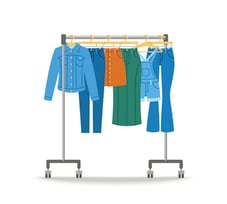
For parents, it means more uncertainty. For teachers, it means being flexible and adopting a new approach to leading a classroom. For retailers who are used to doing billions of dollars in sales of school supplies during the normally bustling back-to-school shopping season, it means things are going to look a lot different this year.
Let’s talk about what retailers should expect for 2020 back-to-school shopping and some marketing strategies to help you curtail the impact of the coronavirus on your school supply sales.
Back-To-School Shopping by the Numbers
In 2019, American families spent an estimated $27.8 billion on supplies for school, including clothing, paper supplies like pencils and notebooks, and electronics. That breaks down to roughly $519 per child.
While a growing portion of school supply shopping is done online, the majority–56% of spending–still takes place in brick and mortar stores. Last year, families made an average of 16 physical trips to the store to purchase back-to-school items. Big box stores like Walmart and Target made up the largest proportion of in-store school-related shopping in 2019.
With these major chains still open across the country, brick-and-mortar school supply shopping is likely to remain strong even in the face of the pandemic. Still, as more consumers shy away from crowded public places, retailers face a more pressing need to offer simple and convenient online options for finding and purchasing school supplies.
Follow these tactics to adapt to consumers’ evolving demands as the “new normal” hits school shopping season.
1. Make Online Shopping Easy
Shopping for school supplies typically means working through a long list of low-value items like pencils, markers, folders, and assorted paper goods. It’s easy to see why parents typically opt to grab these items in a physical store–you can throw them in the cart and check them off the list as you go. Hunting them down and keeping track of what’s in your cart in an online setting isn’t nearly as simple.
Make the experience of shopping online for supplies for school easier on your customers with features like front-page showcases, collection pages grouping related items, and bundles of the most frequently needed products.
Another online shopping hurdle is the shipping; it’s easy to justify paying for shipping on a large household item, but paying a fee that rivals the cost of the very items in the cart is a non-starter for many shoppers. To help shoppers overcome this roadblock, offer free shipping with a low minimum purchase value, like $25 or $30. Display convenient, personalized reminders to help push them over the threshold, like ‘just $5 away from free shipping!’
 2. Shift the Focus Off Clothing
2. Shift the Focus Off Clothing
In years past, clothing and accessories have comprised the largest portion of back-to-school spending, accounting for 51% of school-related purchases in 2019.
This year, retailers can’t rely on an apparel-driven boom. Some households may hold off on clothing purchases until they see whether kids will, in fact, return to a physical classroom, while others who are tightening their belts across the board will deem clothes shopping a non-necessity this year.
Instead, shift your marketing focus to essentials like the classroom supplies we mentioned above and electronics like calculators and tablets that supplement the learning experience.
3. Use Strategic Discounts
In Deloitte’s annual back-to-school survey, parents said price was by far the most important factor that influenced their decision to buy school supplies. Capitalize on this customer demand by offering competitive pricing and deals like buy-one-get-one offers and dollar- or percentage-based discounts.
Research has shown that percent-based discounts (i.e. 30% off) work best for products under $100, while dollar-based discounts (i.e. $30 off) work best for products over $100. Showcase your pricing in clear, bold fonts and lead with it in marketing materials like email campaigns.
Use a ‘recommended products’ widget on your products page to show customers additional items that other shoppers purchased, and upsell complementary add-ons (i.e. ‘add a three-ring binder for just $3!’) during checkout to bump up your average cart size.
4. Timing Is Key
With parents still posting graduation photos and rejoicing about the end of ‘homeschooling’ for this school year, it might feel like the fall is an eternity away. In fact, though, it’s not too soon to get your marketing game plan in place for a strong back-to-school shopping season.
The majority of spending on school supplies traditionally takes place during the last two weeks in July and the first two weeks in August. So, now is the time to plan and prepare your on-site messaging, ad campaigns, marketing emails, limited-time offers, and other marketing materials so they’re ready to go live during prime shopping time.
5. Sell Convenience
The current state of affairs for American homes with children is chaotic. Parents are under unprecedented levels of stress juggling work and home life and millions are battling challenges they’ve never faced before, like economic uncertainty and food insecurity. If you want to win the attention of worn-out consumers, you have to lead with convenience.
Craft marketing messaging that conveys how shopping with you makes life easier in the classroom and at home, whether that’s through fast delivery, curbside pickup, convenient pre-selected supply bundles, or a mobile shopping app. Whatever you can do to make it easier to shop for supplies for school will help you edge out the competition and become your customers’ back-to-school supplier of choice.
Centralize Your Back-To-School Marketing With Springbot
Bridge the divide between your various sales and marketing channels with data-driven marketing tools from Springbot. Our convenient dashboard integrates your website, social media, email marketing, online ads and more so you can automate, analyze and personalize your back-to-school marketing campaigns from within one convenient dashboard.
See Springbot in action for free by scheduling your free demo today. Find more marketing tips and resources for retailers in our Resource Center.





